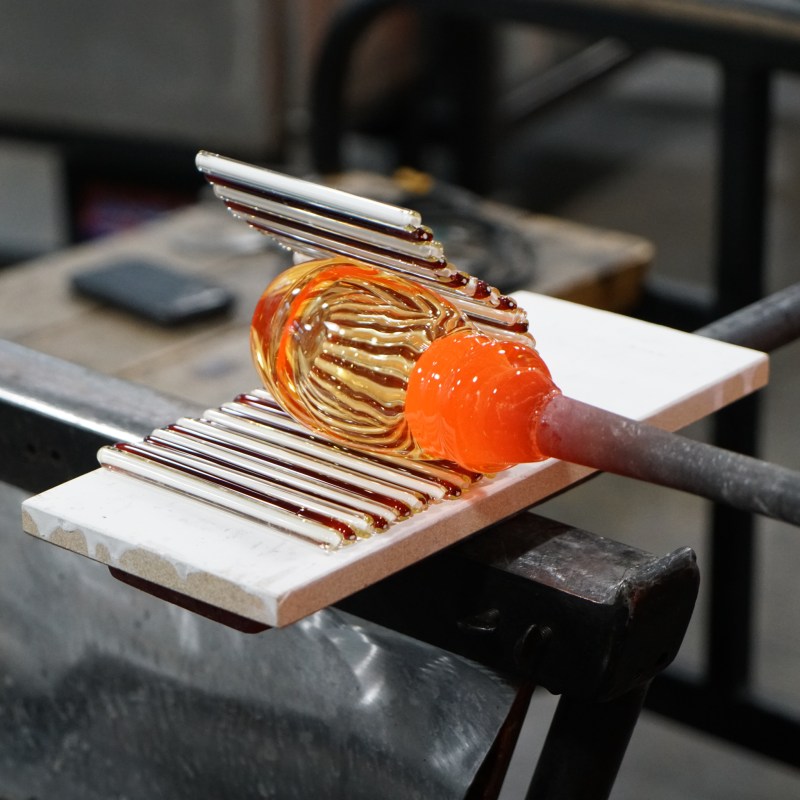
Have you ever participated in glassblowing? I didn’t know much about the practice or how it was done until I visited the Corning Museum of Glass and participated in a Make Your Own Glass Experience.
Videos by TravelAwaits
Glassblowing is taking a blob of molten glass and shaping it into something interesting or a beautiful piece of art by blowing air into it through a hollow tube. It sounds simple enough, but there is a bit more involved. Those who are experts at glassblowing are master artists.
If, like me, you are a novice or haven’t heard much about glassblowing, you may think it is a new modern trend. The truth is, glassblowing has been around since the first century B.C. Syrian craftsmen blew glass for everyday and luxury items produced and exported to various parts of the Roman Empire.
Editor’s Note: To learn more about the museum experience, consider Robin’s 19 Tips For Visiting The Corning Museum Of Glass.
The Make Your Own Glass Experience
Two years ago, when I attended the TBEX Conference in Corning, New York, at the Corning Museum of Glass, one of our options was to participate in a Make Your Own Glass Experience. It sounded fun, so I signed up.
When participating, you are required to sign up in advance since spots are limited. You can sign up online or sign up when you arrive at the museum; just know if you wait until the day, you might not get a spot.
There are three options for the Make Your Own Glass Experience you can register for: glassblowing, glass fusing, and sandblasting. You have to make the decision when you register.
All three are fun and engaging activities for all ages. You need no experience, and each activity is completed in approximately 45 minutes or less, depending on the project.
When I visited, it was in October, and I participated in a glassblowing experience. I created a pumpkin that turned out beautifully.
These activities are popular, and spots fill quickly. I recommend booking your experience online when you get your tickets. The hands-on experiences are an extra fee.
After registration, you are instructed to arrive a bit early for the experience to complete the paperwork. I had registered for the glassblowing and had to choose the item I was making. It was fall, so I chose a pumpkin. In winter, they have tree ornaments, snowmen, and more.
Once the paperwork is completed, you are escorted into the hot shop (glassblower’s workshop).

Upon entering, you are given safety glasses and instructions on what to touch and how to stay safe and avoid getting burned.
When I visited, there was about a 25-minute wait from the time I completed my instructions till I could participate. This was great because it allowed me to watch others create their masterpiece and get a feel for how it all worked.
The glassblowers were demonstrating and educating everyone in the room. I learned that glassblowing has been popular since the time of the Roman Empire.
You start by picking your color of glass and then if you want any coordinating colors mixed in.

Some chose to make a blue pumpkin. Some made red. The blue tempted me since it is my favorite color, but I decided to go with the traditional orange with yellow touches.
Inside the furnace is a crucible or pot of glass; it was being charged or melted at 2,000+ degrees Fahrenheit.

My Turn For Glassblowing
When it was my turn, I donned the safety glasses and started with a glob of molten glass the consistency of thick molasses or taffy. It is gathered at the end of a hollow pipe about 4 feet in length. The blob is dipped into the various glass color chips selected and put back into the fire.

When the pipe is removed from the fire and the glass is secure, the other end of the pipe is cooled in water and then put into a stand. The gaffer (person blowing the glass — me) wipes the end of the tube with alcohol swabs and then attempts to inflate the blob into a bubble slowly.
The bubble is then formed into the shape by rolling on a smooth surface, swinging, and more blowing.

The partially blown glass, known as a parison, is turned around and around as it is being shaped.
Additional glass chips or colorants can be added at this time.

Sometimes before your masterpiece is finished, the glass cools to the point where it is unworkable. It is put into a smaller furnace and supported on the rotating blowpipe to heat the glass enough to continue.
Finishing Touches
My pumpkin’s stem was added by manipulating glass with hand tools and cut with shears while the glass was still soft. This is how handles and other decorative items are added.

After the Make Your Own Glass experience is over, the item you made has to cool. The glass needs to be cooled slowly at a specific rate so it doesn’t crystallize. If it starts to cool too quickly, the glass suffers thermal shock and sometimes breaks. The size and shape of the glass object affect the rate and length of cooling.

I was given a window of time the following day to return to pick up my pumpkin.
If you are not going to be at the museum the following day, you can have your creation shipped to you for an extra fee.
What Surprised Me …
I was surprised by the amount of work that goes into making a small glass object. I can only imagine the amount of work and time that goes into some of the larger items they create, like the 95-pound pumpkin they had on display along with several other large pumpkins as you entered the museum.
What surprised me most was how little I knew about glass. We use it so often in our everyday life, yet I didn’t know much about the ingredients, the process, or the history until I visited the Corning Museum of Glass.
… And What Shocked Me
The amount of heat involved in creating the items was shocking. I would think there would be significant safety concerns for employees. Glassblowing is challenging work, and I can see where there are a lot of risks involved. The glass can crack and explode if mistakes are made, and people could get burned with the hot glass.
The glassblowers wore protective clothing, safety glasses, giant oven mitts, and other safety attire. But all the danger involved shocked me.
What I Would Do Differently Next Time
Now that I know what all is involved, I would wear more casual clothes, and I would not be upset with myself if my project didn’t turn out perfect the first time and needed to be reheated. Also, I would do it earlier in the day, and I would probably sign up for more than one hands-on glass experience. It was a lot of fun.
My Glassblowing Advice
If you have the opportunity to visit a place where you can experience glassblowing, I highly recommend it. The Corning Museum of Glass offers their Make Your Own Glass Experience daily throughout the year. Check their website for times since they fluctuate with the seasons.
The Corning Museum of Glass is between New York City and Niagara Falls. It is a destination in itself, but there are many things to do around the Finger Lakes area, including gorgeous lakes, Watkins Glen State Park, wineries, distilleries, craft breweries, and spectacular views. So there is plenty to do if you plan to spend some extra days in the area.
Pro Tip
You must purchase tickets for the Corning Museum of Glass online in advance. The Glassblowing experience is extra. The museum tickets are for 2 days. There is a lot to see and do at the museum, and you should take advantage of the time and check out all the exhibits, gift shop, and activities.
Related articles:
